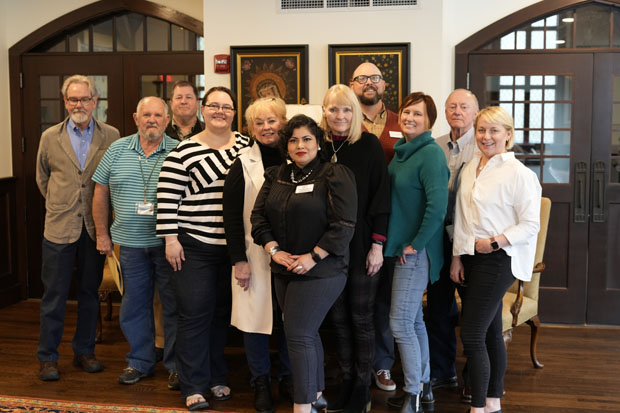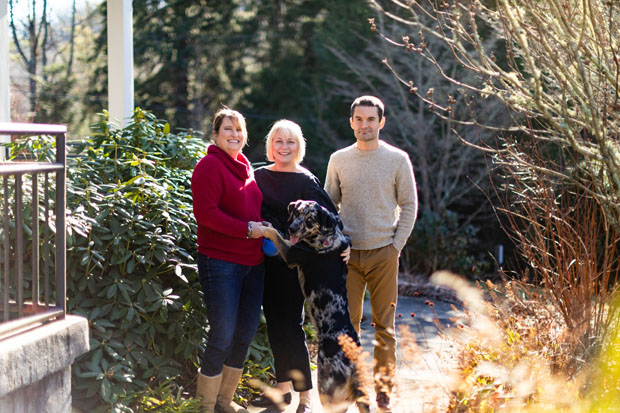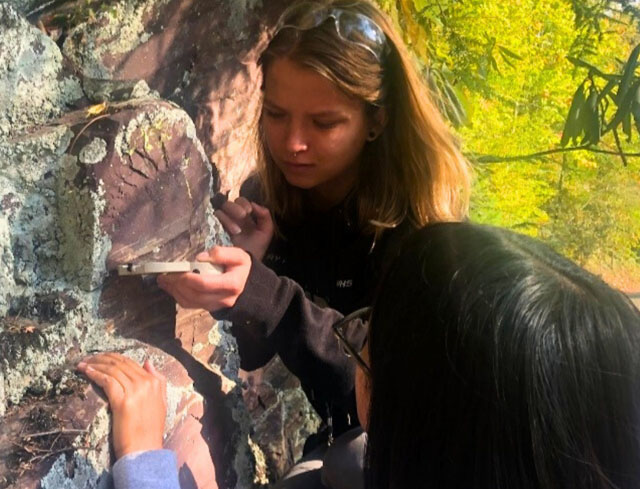A Place to Call Home
05 Apr 2023
Local Non-Profits seek to address affordable housing conundrum
Story by T.J. Smith

On November 3rd of last year, a group of directors and program managers from non-profits across the plateau met up at the Episcopal Church of the Incarnation for an informal lunch. The meetup was the brainchild of myself, Leslie Manning, Executive Director of The Counseling Center, and Emily Wilmarth, co-pastor for the First Presbyterian Church of Highlands—the three of us having remarked to each other on numerous occasions, “We really need to get everyone together and have a conversation.”
We had 14 individuals, representing two churches and nine nonprofits, together for lunch and to discuss pressing issues that we were seeing through the work of our respective organizations. In that first meeting, our focus was directed on affordable housing, a topic that had been on the periphery of everyone’s minds, swirling around with other issues like short term rentals (STRs), gas prices, and inflation. There were a variety of perspectives on causes and solutions; however, one thing that everyone agreed upon was access to affordable housing is a primary stressor for many of the individuals and families we serve everyday—the same individuals and families who clock into the jobs that keep things running on the plateau.
This is not my first rodeo when it comes to the issue of affordable housing. Back in 1998, I was a 21-year-old journalist living in the high plains desert of northwestern Colorado. The town where I worked as the managing editor of a small weekly was not the most engaging place for a young person to live. Fortunately for me, this was Colorado and there was excitement to be had mere hours away by car. I enjoyed hitting the trails around Aspen and going into town for a beer and a bite to eat.
It was in Aspen that I was introduced to the housing conundrum of resort town life and the reality that accessible housing did not exist for many of the service workers who kept Aspen residents and visitors alike fed, imbibed and generally entertained. These workers, from the barbacks to cleaning staff to retail clerks, were traveling anywhere from 40 to 60 miles into work because affordable housing was nearly nonexistent. One such worker told me, “They had to put in government housing for the doctors and nurses that work at the hospital because even they can’t afford to live here.” That stuck with me.
It wasn’t just local folklore. The county and city governments serving Aspen did initiate subsidized housing for workers as far back as 1974. Aspen, the “middle-class city with a billionaire problem” as named by a 2015 article in the Colorado Independent, acted early to address the housing issue as it grew into the resort town we know today. By the 1990s, however, individuals with net assets which would label them as upper-upper middle class anywhere else, qualified them for government assistance in Aspen. In fact, in 2022, individuals with net assets nearing $1 million qualified for subsidized housing in Aspen’s Pitkin County.
Today, similar townships relying heavily on tourism—from Tahoe to Breckenridge to right here in Highlands and Cashiers—are seeing workforces pushed further and further outward by increasing housing costs. Despite best efforts by both public and private entities, the workers who keep these towns running are finding fewer and fewer housing options within an hour’s commute to their jobs. The situation begs the question: how long is this sustainable?
According to the most recent county figures from the Department of Housing and Urban Development (HUD), the fair market rental costs for a two-bedroom residence in Macon and Jackson Counties are $881/month and $778/month, respectively. Fair market rental figures are calculated to include the cost of utilities, so when considering those numbers above, also consider the cost of essential utilities, including electric and/or gas (if applicable) and water and sewer.
According to www.rentdata.org:
When deciding how much they should charge for their rental units, landlords and property managers look at something called “Fair Market Rent.” Federal agencies also use the Fair Market Rent (FMR) amount to determine the fair amount of assistance. The Fair Market Rent amount is useful to determine the amount to charge for rent, and it’s based on various factors, including the square footage and local housing market. (https://www.rentdata.org/articles/what-is-fair-market-rent).
FMR is calculated by surveying “the 40th percentile of rent paid by people who have moved in the last two years in any given area.” In other words, it is calculated below the median average of rental rates, but FMR is not what people are actually paying for rent in these parts.
Taking a cursory browse around the internet, and after omitting the outliers (a $10,000/month two-bedroom in Highlands and $1200/month two-bedroom in Franklin), rents on a two-bedroom home or apartment in Macon and Jackson Counties average $2,137. According to the North Carolina Justice Center, in order to afford a two bedroom in this area, a minimum wage worker must put in 94 hours a week, or a working couple must put in 47 hours/week each to afford rent.
My thoughts immediately go to single parents or those homes in which one parent works and one has to stay home to raise children. How do they get by? How do they manage?
Access to affordable housing is a national issue. Just this past January, Moody’s Analytics reported that the US had, for the first time, become cost-burdened nationwide, meaning that the national rent-to-income (RTI) ratio now averages 30%. A 30% RTI has often been referenced as the threshold that indicates a household is financially burdened by housing costs. In the 20 years since Moody’s began tracking this data, the nationwide RTI average had never reached 30% … until January.
In Macon County, where 27% of the population rents their home, 47% of all renters are at or above that threshold. They are rent-burdened. Very-near-the-same percentages are true of Jackson County, with differences at just tenths of a percent.
In 2020, the Highlands Chamber of Commerce conducted a housing survey with local business owners and leaders as part of its larger work towards a unified community plan (which was published in June 2022). The Chamber surveyed 124 individuals. Only 34 responded.
Yet, in those 34 responses, there was overwhelming consensus that, from the perspective of responding businesses, Highlands does not have “diverse and attainable” housing options. These responses included comments such as, “not enough housing for hourly employees” and “Highlands is seriously lacking in workforce housing” and “this has been a problem since I moved here 24 years ago.”
The Chamber survey also asked the peripheral issue of worker commute times and distances. Out of the 34 respondents, 33 noted that they have employees traveling 30 minutes to an hour for work. Finally, in the 2022 community plan, out of the respondents of the 2020 survey and of a different 2021 survey, 0% of business owners agreed that “housing for employees is readily available. 0%.
A lot of potential solutions were voiced in our non-profit leader lunch meetings: public/private partnerships, land trusts, conservation easements, subsidies, zoning reform to allow for multi-family construction, etc. All good ideas, but with no housing non-profit on the plateau—no full-time advocate keeping the issue on everyone’s radar—who will take it on?
Of course, we discussed that some local employers “provide” housing to their employees, meaning those businesses maintain properties, which they rent to their employees for reduced rates. That sounds good at first, until you consider what it means to possibly lose your job and your home all at once. This kind of housing is a solution for the employers to create a dependable workforce, not to create an equitable and sustainable housing solution for working people.
The discussion on housing extended into our second lunch meeting in December. Before the month ended, the housing issue was compounded by a chain of minor disasters that included several homes flooded and two burned down, displacing some of the few working families still living on the plateau. One of those families is now living in Franklin, joining the hundreds of others who are commuting half an hour or more to work in Highlands and Cashiers.
They are lucky to have found something. Even housing in Franklin, to the south of the plateau, and Sylva, to the north, is becoming less affordable and harder to find. With rising prices, higher demand, inflated gas prices and second homes being converted to STRs, the availability of housing for those on whom we depend most is quickly disappearing. When they have nowhere to live here, wage workers will be forced to move on to larger towns and cities. When that happens, there will be little to no local workforce. What this means goes beyond the impact to local businesses. The loss of a workforce weakens our community and makes us vulnerable. For those who don’t recognize the dangers of that, unfortunately, you may get to see it first-hand … and sooner than you think.
If you are interested in working with these non-profits or would like to learn more about the benefits of and challenges to affordable housing, we will be holding town halls in both Macon and Jackson counties later this year. Interested individuals should sign up using the sheet at this link: https://tinyurl.com/y3ybxwwv. You can also send an email with your name and the city and county where you live to tj@internationalfriendshipcenter.org, and we will place you on our notification list. We hope you will choose to get involved. We are stronger together.













